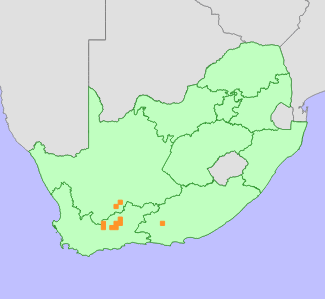|
Scientific Name | Peersia frithii (L.Bolus) L.Bolus |
Higher Classification | Dicotyledons |
Family | AIZOACEAE |
Synonyms | Mesembryanthemum frithii L.Bolus, Rhinephyllum frithii (L.Bolus) L.Bolus |
National Status |
Status and Criteria | Vulnerable B1ab(iii,iv,v) |
Assessment Date | 2019/10/24 |
Assessor(s) | D. Raimondo |
Justification | Peersia frithii is a species previously collected widely throughout the southern Karoo with a historic extent of occurrence (EOO) of 28 913 km². It has only been recorded seven times since 1990, and is suspected to be extant at 6 locations from a current EOO of 690 km². Decline is suspected to be the result of livestock overgrazing and trampling. This species therefore qualifies as Vulnerable under criterion B1ab(iii,iv,v). The generation length is unknown hence an A criterion listing is not possible. |
Distribution |
Endemism | South African endemic |
Provincial distribution | Eastern Cape, Northern Cape, Western Cape |
Range | This species is endemic to South Africa, and is found from Laingsburg to Aberdeen. |
Habitat and Ecology |
Major system | Terrestrial |
Major habitats | Koedoesberge-Moordenaars Karoo, Eastern Upper Karoo, Western Upper Karoo, Eastern Lower Karoo, Gamka Karoo, Matjiesfontein Shale Renosterveld, Southern Karoo Riviere |
Description | It occurs on slopes or flats of finely weathered Ecca shales. |
Threats |
| Large-scale shale gas fracking was proposed in 2015 for the Karoo basin covering the majority of this species' range. A Strategic Environmental Impact Assessment submitted to South Africa's Department of Environmental Affairs in 2016 cautioned against moving ahead with Shale Gas fracking based on the very high infrastructure costs associated with fracking as well as multiple secondary negative impacts both to biodiversity and other economic activities in the region. Furthermore geological studies that have taken place since 2016 have found that gas deposits are not as substantial as originally suspected due to the very old age of the Karoo shale formations and the fact that the extensive number of dolerite intrusions throughout the Karoo have resulted in much of the gas being lost. At present, future development scenarios are too uncertain to estimate the potential extent of the impact on the population but it is unlikely that shale gas fracking will proceed in the near future.
This species is also grazed by livestock and there are very few recent collections (only seven records collected since 1990) which is likely to indicate that the population has already declined extensively due to livestock overgrazing. |
Population |
There is limited data on the population structure and trends of Peersia frithii, only seven records of this species have been made since 1990 and it was not found in any of the surveys of the Karoo BioGaps project that sampled widely across the Karoo Basin between 2015 and 2018. We suspect that there has been a significant decline over the past 80 years due to livestock overgrazing and trampling.
|
Population trend | Decreasing |
Notes |
| Peersia is a poorly known genus in need of taxonomic revision. Species are difficult to identify with certainty. |
Assessment History |
Taxon assessed |
Status and Criteria |
Citation/Red List version | | Peersia frithii (L.Bolus) L.Bolus | VU B1ab(iii,iv,v) | 2020.1 | | Peersia frithii (L.Bolus) L.Bolus | Least Concern | Raimondo et al. (2009) | |
Bibliography |
Bolus, H.M.L. 1928-1935. Notes on Mesembrianthemum and allied genera. Part II. Bolus Herbarium, University of Cape Town, Cape Town.
Bredenkamp, C. In prep. Conspectus of the flora of the Eastern cape. Strelitzia.
Raimondo, D., von Staden, L., Foden, W., Victor, J.E., Helme, N.A., Turner, R.C., Kamundi, D.A. and Manyama, P.A. 2009. Red List of South African Plants. Strelitzia 25. South African National Biodiversity Institute, Pretoria.
Snijman, D.A. 2013. Plants of the Greater Cape Floristic Region 2: The extra Cape flora. Strelitzia 30. South African National Biodiversity Institute, Pretoria.
|
Citation |
| Raimondo, D. 2019. Peersia frithii (L.Bolus) L.Bolus. National Assessment: Red List of South African Plants version 2024.1. Accessed on 2025/12/10 |
 Comment on this assessment
Comment on this assessment


